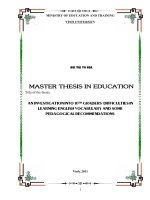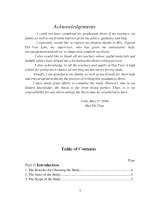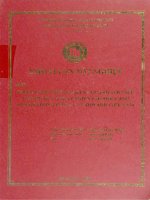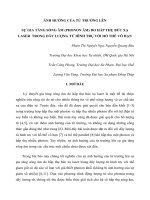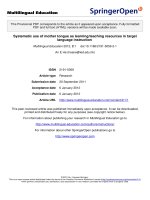The interference of mother tongue as vietnames in learning english souds and stress at high school = ảnh hưởng của tiếng mẹ đẻ đối với việc học âm và trọng âm tiếng anh ở trường phổ thông
Bạn đang xem bản rút gọn của tài liệu. Xem và tải ngay bản đầy đủ của tài liệu tại đây (480.54 KB, 50 trang )
Acknowledgements
I could not have completed my graduation thesis if my teachers, my
family as well as my friends had not given me advice, guidance and help
I especially would like to express my deepest thanks to Mrs. Nguyen
Thi Van Lam, my supervisor, who has given me enthusiastic help,
encouragement and advice to shape and complete my thesis.
I also would like to thank all my teachers whose useful materials and
faithful advice have helped me a lot during the thesis writing process.
I also acknowledge to all the teachers and pupils at Gia Vien A high
school for giving me a chance of carrying out the survey for my study.
Finally, I am grateful to my family as well as my friends for their help
and encouragement during the process of writing this graduation thesis
I have made great efforts to complete the study. However, due to my
limited knowledge, the thesis is far from being perfect. Thus, it is my
responsibility for any shortcomings the thesis may be considered to have
Vinh, May 2nd 2006
Mai Thi Thuy
1
Table of Contents
Page
Part I: Introduction
1. The Reasons for Choosing the Study............................................................4
2. The Aims of the Study...................................................................................5
3. The Scope of the Study .................................................................................5
4. The Methods of the Study ............................................................................5
5. The Design of the Study ...............................................................................6
Part II: Investigation
Chapter 1: Theoretical Background
1.1. Interference ..............................................................................................7
1.1.1. Language Interference ............................................................................7
1.1.2. Causes of Interference in Learning Language.....................................7
1.1.3. Mother Tongue Interference................................................................8
1.2. Pronunciation...........................................................................................9
1.2.1. Sounds......................................................................................................9
1.2.1.1. Production of Sounds ...........................................................................9
1.2.1.2. Articulators......................................................................................10
1.2.1.3. Types of Sounds ...............................................................................1
1.2.1.3.1. Vowel Sounds .................................................................................10
1.2.1.3.2. Consonant Sounds...........................................................................10
1.2.2. Stress......................................................................................................11
1.3. Vietnamese Pronunciation.....................................................................11
1.3.1. Vietnamese Vowels...............................................................................11
1.3.2. Vietnamese Consonants........................................................................12
1.4. English Pronunciation ........................................................................ 13
1.4.1. English Vowel .......................................................................................13
1.4.2. English Consonants................................................................................14
2
1.5. Summary
Chapter 2: Differences between English and Vietnamese
Pronunciation
2.1. Vowels.......................................................................................................15
2. 2. Consonants..............................................................................................20
2.2.1 Fricative Consonants...............................................................................20
2. 2.2. Word-Final Voiceless Consonants /p/, /ƚ/, /k/.....................................21
2.2.3. Fricative Consonant /θ/......................................................22
2.2.4. Fricative consonant /ð/.........................................................................23
2. 2.5. Aspirated Consonant /ƚ/ in the Initial Position......................................24
2. 2.6. Consonant Clusters................................................................................24
2.2.6.1. Consonant Clusters in English ...........................................................25
2.2.6.2. Consonant Clusters in Vietnamese......................................................26
2.3. Sound Linking.........................................................................................26
2.3.1. Sound Linking in English.......................................................................26
2.3.2. Sound Linking in Vietnamese................................................................27
2. 4. Sound- Spelling Correspondence.........................................................28
2. 4.1. Principles of Constructing Spelling.......................................................28
2. 4.2. Sound- Spelling Correspondence...........................................................29
2. 4.2.1. Sound- Spelling Correspondence in English......................................29
2. 4.2.2. Sound- Spelling Correspondence in Vietnamese...............................29
2. 5. Pronunciation of Grammatical Endings...........................................30
2. 5.1. Pronunciation of Grammatical Endings in English ..........................30
2.5.1.1. The Importance of Pronunciation of Grammatical Endings...............30
2. 5.1.2. Types of Grammatical Endings..........................................................30
2.5.2. Pronunciation of Grammatical Endings in Vietnamese.........................31
2.6. Pronunciation of Contractions..............................................................32
2.7. Word Stress.............................................................................................33
3
2.7.1. Word Stress in English .........................................................................33
2.7.1.1. Definition..............................................................................................3
2.7.1.2. Importance of Word Stress.................................................................34
2.7.1.3. Characteristics of Word Stress...........................................................34
2.7.2. Word Stress in Vietnamese...................................................................35
Chapter3: The Survey...................................................................37
3.1. Overview of the Survey ......................................................................37
3.1.1 Aims of the Survey ............................................................................37
3.1.2. Informants and their background.......................................................37
3. 2. Description of the Survey Questionnaire.........................................38
3.3. Findings and Discussions....................................................................38
3.3.1. The Results............................................................................................38
3.3.2. Discussions............................................................................................39
Chapter 4: Suggestions for Practising English Sounds and Stress ..........41
4.1. Vowels......................................................................................................41
4. 2. Consonants.............................................................................................45
4. 3 Sound Linking........................................................................................49
4.4. Sound - Spelling Correspondence.........................................................50
4. 5. Grammatical Endings...........................................................................51
4. 6. Contraction............................................................................................52
4. 7. Word Stress............................................................................................52
Part III: Conclusion.............................................................................54
References.................................................................................................55
Appendix
4
Part I: Introduction
1. The Reasons for Choosing the Study
Everyone is now aware of the importance of English, which is the reason
why English is learnt with the great motivation. However, it is not easy to
master and use it effectively because of many reasons such as learning
environment, age, ability and especially mother tongue interference. It is shown
that interference appears in almost aspects of English like grammar,
preposition, article especially pronunciation, which is really important. It is
important for the following reasons.
Firstly, it is pronunciation and the first impression. It is clear that
pronunciation is definitely the biggest thing that people notice when we are
speaking English. When we meet a native person, he could already tell if our
English is good or bad. He realizes our English is good or bad because we use
advanced grammar structures or difficult words. In fact, it is not structures or
words but pronunciation that helps him to realize that. Thus, in communication,
the
first
thing
that
people
can
realize
is
pronunciation.
Secondly, it is pronunciation and meaning. Pronunciation should be one of the
first things that learners study in English. We can communicate without
advanced vocabulary because we can use simple words to express what we want
to say. We can communicate without advanced grammar because we can use
simple grammar structures in stead. However, there is no such as thing as
simple pronunciation. If we have bad pronunciation, even if we use advanced
vocabulary or grammar, people may not understand what we want to say. Thus,
pronunciation creates meaning that helps people understand each other when
communicating.
5
Like learners from other countries, Vietnamese learners are coping with
many difficulties in pronouncing English. The main cause, which can be seen,
is the mother tongue interference. It is shown that there are so many differences
between English and Vietnamese pronunciation. Therefore, Vietnamese
learners fail to pronounce English successfully. As an English learner for many
years, the author can see mistakes that her friends and pupils have made when
she hears them speak. These mistakes are regarded to be frequent and prevent
them from speaking English correctly. For the reasons above, the author
decides to work on "The Interference of Mother Tongue as Vietnamese in
Learning English Sounds and Stress at High School".
2. The Aims of the Study
This thesis aims to:
-Compare Vietnamese pronunciation and English pronunciation and find
out differences between them. These differences are regarded as the proofs of
difficulties to learners
- Demonstrate how Vietnamese affects English pronunciation learning by
analyzing those differences
-Provide some suggestions for the problems that have been mentioned with
the hope that they could make a small contribution to the improvement in
teaching English especially in teaching pronunciation in Vietnam
3. The Scope of the Study
In this thesis, mother tongue interference in pronunciation is dealt with.
However, the thesis cannot cover all the problems related to pronunciation but
for the effect of mother tongue in vowels, consonants, sound linking and stress.
4. The Methods of the Study
With the aim to compare and demonstrate differences between English
and Vietnamese pronunciation, the following methods have been used during
the study process:
-Contrastive analysis
-Investigative method
6
-Collective method
-Illustrative method
5. The Design of the Study
The thesis consists of three main parts:
Part I is the introduction of the thesis in which we present the reasons for
choosing the subject, the aims, the scope, the methods and the design of the
thesis.
Part II is the development with four main chapters:
Chapter 1 entitled, "Theoretical Background", which provides information
about interference, Vietnamese and English pronunciation.
Chapter 2 provides a comparison between English and Vietnamese
pronunciation.
Chapter 3 deals with the survey and the results.
Chapter 4 is about suggestions for the problems mentioned.
Part III is the conclusion of the thesis, which summarizes the contents
mentioned in part II.
Besides these three main parts, the thesis also opens with the
acknowledgements, the table of contents and ends with the references and
appendix.
7
Part II: Investigation
Chapter 1: Theoretical Background
1.1. Interference
1.1.1. Language Interference
To understand clearly what language interference means. We will put
language interference in the process of learning a language because interference
and this process are related closely to each other.
We know that the process of learning a new language is the one of
gaining a new habit system. In that process, the habits of using the mother
tongue affects language learning. This effect consists of two aspects, negative
and positive. The positive effects called ‘transfer’ are ones that are useful to
learning process. On the contrary, negative effects cause difficulties to learning
process and they are called ‘ Interference’.
According to pedagogy- living language viewpoint, interference is a kind
of special errors that learners meet because of their habits or natural effects
from the mother tongue into the target language. As a result, errors appear and
learning is out of the standard of the target language.
1.1.2. Causes of Interference in Learning Language
According to Nguyen Van Chien (1992:30), there are some causes of
interference in learning language
The first one is learner’s habit. When learning a new language, learners
have a habit of applying this language’s elements to another language.
According to the Behaviorism, it is assumed that a person learning a second
language starts off with the habits associated with the first language. These
8
habits interfere with those needed for second language speech and new habits
must be formed. Besides, in the Contrastive Analysis Hypothesis where there
are similarities between the first language and second one, students will learn
structures with ease; where there are differences, the learner will have
difficulties that may lead to making errors.
In addition, age and competence also cause interference. People think
that, the young especially the children tend to learn language more quickly than
the old. At the certain language level, these children will get less interference
than the other. Because the mother tongue has not become a system of sign that
is present deeply in their mind, therefore the children’s mother tongue has a few
natural elements that cause interference.
Besides the method of teaching is also an important problem that is
related to language interference such as time, deadline, language environment,
linguistics, teaching lessons and reasonable time division.
The last one is communicative situation. If the speakers are forced to
speak a language that is related to a topic spoken by another language,
interference might happen. In other words, differences in communicative
function or language in social situation can cause interference. This is a field of
communicative habits attached tightly to specific situations in family, in
schools or outside the society (at markets or offices) and to different language
styles like communicative and scientific languages.
1.1.3. Mother Tongue Interference
Mother tongue interference is defined as the use of elements from one’s
native language while learning the second language. It is one of the causes of
error. When we learn a foreign language, there are, of course, many other
influences, but the one that the mother tongue has on the language we produce
when we use a foreign language has become a very important area of study for
people interested in second language acquisition. We know that the language
9
produced by foreign learners is so unavoidably influenced by the mother tongue
of the learner and that is certainly clear. For example:
A German learner says: ‘How much costs the buss?’
A French learner says: ‘ I must to do my homeworks.’
A Spanish learner says: ‘I go to the town walking’
A Vietnamese learner says: ‘This person not old’ or ‘you not write letters.’
From the above examples, we see that it is the mother tongue
interference that makes these learners say the sentences which are full of errors.
Indeed, the mother tongue has a great effect on the English language produced
by learners.
According to Swan and Smith (1999:238), mother tongue interference
appears in many aspects of language. It influences Grammar, vocabulary…etc
especially pronunciation. However, in the scope of thesis, the mother tongue
interference in pronunciation especially sounds and stress is discussed.
1.2. Pronunciation
Pronunciation consists of three aspects: sound, stress and intonation.
However, in the thesis, only sounds and stress are focused on.
1.2.1. Sounds
1.2.1.1. Production of Sounds
According to Roach (1998:20), all the sounds we make when we speak
are the result of muscles contracting. The muscles in the chest that we use for
breathing produce the flow of air that is needed for almost speech sounds while
muscles in the larynx produce many different modifications in the flow of air
from the chest to the mouth. After passing though the larynx, the air goes
through the vocal tract, which ends at the mouth and nostrils. Here the air from
the lungs escapes into the atmosphere.
10
1.2.1.2. Articulators
Fig.1 The Articulators
According to Roach (1998:20), articulators consist of nose, upper lip, lower
lip, upper teeth, lower teeth, alveolar ridge, tongue (including tip, blade, front,
back and root), hard palate, short palate, velum, pharynx and larynx.
1.2.1.3. Types of Sounds
1.2.1.3.1. Vowel Sounds
From the common view, vowels are considered to be sounds in which there
is no obstruction to the flow of air as it passes from the larynx to the lips.
Vowels are distinguished according to four characteristics which are tongue
height (whether the tongue is high or low in the mouth), front or back of tongue
(whether vowels are pronounced in the position of the front or the back of the
tongue), tenseness/ laxness (whether the muscles are tense or lax) and lip
rounding (whether the lips are rounded, spreaded or neutral).
1.2.1.3.2. Consonant Sounds
Consonant sounds are considered to be difficult or impossible for the air
to pass through the mouth. Consonant sounds have the following characteristics:
The first is place of articulation (where in the mouth the air stream
obstructed). According to the places in the mouth, consonants are called
bilabial, labiodentals, glottal, velar, and alveolar.
11
The second is manner of articulation (the way in which the air stream is
obstructed). At the different places of articulation in the mouth, there are
several basic ways that the air stream can be obstructed. We have plosives,
fricatives, affricates and nasals.
The third is voicing that is whether there is vibration of the vocal cords.
Consonants with this feature are divided into types: voiced and voiceless
consonants.
1.2.2. Stress
According to Clarey and Dixson (1963:15), stress is the emphasis given to
a particular syllable within a word or to a particular word within a group of
words. Stress consists of two features, loudness and length.
In term of loudness, that stressed syllables or words are louder than
unstressed ones. It means that loudness is a component of prominence. In a
sequence of syllables or words, if any syllables or words are stressed, we can
hear them more clearly than the others.
Besides loudness, the length of syllables or words also makes a signal of
stressed ones. It is the fact that the length contributes an important part of
syllables or words’ prominence. Thus, when we hear a longer syllable or word,
we tend to think them to be stressed.
1.3. Vietnamese Pronunciation
1.3.1. Vietnamese Vowels
• Medial vowel /u/
This is only phoneme in the second position. It is a semi-tone and
considered as round vowel. Therefore, it does not go with the other round
vowels. It is present in spelling ‘u’ and ‘o’.
• Back vowels
According to Cu Dinh Tu, Hoang Van Thung and Nguyen Nguyen
Tru(1978:55), back sounds consist of fourteen vowels in which there are eleven
12
monophthongs and three complex vowels. Back vowels are divided in the
following groups:
The first is unrounded front monophthongs that are /i/, /e/ and /ε/
The second is rounded back monophthongs that are /u/, /o/, /ɔ/
The third is unrounded back vowels that are /ɯ/, /ɣ/, /ɣ/, /a/, /ă/
The final is complex vowels that are /ie/, /uo/, /ɯɣ/
• Final semi vowels
In the final position, there are two semi-vowels, they are /i/and /u/. /i/
is unrounded front semi vowel. It is present in spelling ‘i’ or ‘y’. /u/ is a
rounded back vowel and its spelling is ‘o’ or ‘u’
Fig.2 Vietnamese Vowels
1.3.2. Vietnamese Consonants
According to Nguyen Huu Quynh (1994:76), there are twenty- seven
consonants of which twenty-one are in the first and six in the final position of
syllables
• Consonants in the first position
Consonants are divided into groups based on manner of articulator and
place of articulators
13
Based on manner of articulator, consonants are divided into stops/b, d, t, t’,
t, c, k, m, n, ɳ, / and fricatives /f, v, s, z, l, Ş, ʐ, Ƴ, Χ, h/; voiced
consonants /b, d, v, z, ʐ,, Ƴ / and voiceless ones /t, t’, t, c, k, f, s, Ş, Χ, h/
Based on place of articulators, initial consonants can be divided into
bilabials /b, m, f, v/, lingual sound /d, t, t’, s, z, n, l, t, Ş, ʐ, c, k, л,ŋ,
Χ/and glottal sound: /h/
• Consonants in the final position
In the final position, Vietnamese has six consonants which are /p, t, m, n, k/
1.4. English Pronunciation
1.4.1. English Vowel
English vowels consist of short vowels, long vowels, diphthongs and
triphthongs.
-Short vowels: There are seven short vowels in English. They are /ɪ/,
/e/, /æ/, /ʌ/, /ɔ/, /ʊ/, /Ə/
-Long vowels: There are five long vowels. They are /i:/, /з:/, /ɑ:/,
/ɔ:/, /u:/
- Diphthongs
Diphthongs ending in /Ə /: / ɪƏ /, /e Ə /, /ʊƏ/
Diphthong ending in /ʊ/: /Ə ʊ /, /a ʊ/
Diphthong ending in /ɪ/: /eɪ/, /aɪ/, /ɔɪ/
-Triphthongs: there are five triphthongs
eɪ
+
Ə
=
eɪƏ
aɪ
+
Ə
=
aɪƏ
14
ɔɪ
+
Ə
=
ɔɪƏ
Əʊ
+
Ə
=
ƏʊƏ
aʊ +
Ə
=
aʊƏ
1.4.2. English Consonants
According to Roach (1998:78), there are 24 consonant sounds in English.
Consonants are defined in the way of manner of articulation and place of
articulation.
Based on the manner of articulation, consonants are divided in the
following groups:
-Plosives: there are six consonants, they are /p/, /Ɨ/, /k/, /b/, /d/,
and /g/.
-Fricatives: there are nine fricative consonants, they are /f/, /θ/, /s/, /ʃ/,
/v/, /ð/, /z/, /Ʒ/ and /h/.
- Affricatives: there are two complex consonants. They are /ʧ/, /ʤ/.
-Nasals: there are three consonants. They are /m/, /n/, and /ŋ/.
-Lateral: There is one /l/.
-Approximant: There are three consonants /w/, /r/, /j/.
Based on place of articulation, consonants are divided into the following
groups:
-Bilabial: there are three consonants: /p/, /b/, and /m/.
-Labiodentals: there are two consonants: /f/ and /v/.
-Dental: there are two consonants: /θ/ and /ð/.
-Alveolar: there are six consonants, they are /Ɨ/, /d/, /s/, /z/, /n/ and /l/.
15
-Plato-alveolar (post-alveolar): there are five consonants: /ʃ/, /Ʒ/,
/ʧ/, /ʤ/, and /r/.
-Palatal: There is one consonant /j/.
-Velar: There are three consonants: /k/ and /g/.
-Glottal: There is one consonant /h/.
1.5. Summary
In this chapter, we have discussed the theoretical foundations including
interference, pronunciation, Vietnamese and English pronunciation for the
analysis of the differences between English and Vietnamese pronunciation in
the later chapter II.
16
Chapter 2
Differences between English and
Vietnamese Pronunciation
You may know there are both similarities and differences between
Vietnamese pronunciation and English pronunciation. However, in this chapter
only differences that cause difficulties to learners are focused on. As the sound
systems of English and Vietnamese differ greatly, the Vietnamese language can
have pronunciation problems. For example, the Vietnamese vowel system
makes a large number of differences; therefore, Vietnamese learners face too
many difficulties with the English vowels. Besides, Vietnamese has no clusters
as English. Moreover, Vietnamese is a tone language or most words in
Vietnamese consist of only one syllable.. etc…The differences like that will be
mentioned in this chapter to demonstrate that Vietnamese has an effect on
learning English pronunciation.
2.1. Vowels
For some Vietnamese learners, vowels are thought to be easy to
pronounce because there are some Vietnamese vowels in Vietnamese that seem
to be like English ones. Thus, English vowels may be pronounced in the way of
Vietnamese vowels. In fact, English vowels are not pronounced as Vietnamese
vowels. A vowel in Vietnamese such as /i/ does exist in the mother tongue,
however, this vowel is separated in English that consists of two separated
vowels /i:/ and /ɪ/. As a result, many learners pronounce /i/ for both /i:/ and /ɪ/.
As mentioned, a vowel does exist in the Vietnamese language, but not a
separate vowel causes difficulties to learners. Learners often produce the two
vowels of each pair identically. It means that they do not pronounce /i:/ or /ɪ/
but pronounce /i/. They fail to make these distinctions that may lead to
17
misunderstanding. For example, ‘sleep’ may sound ‘slip’ and ‘sheep’ may
sound ‘ship’.
Pairs of English vowels such as /i:/ and /ɪ/, /æ/ and /e/, /ɔ:/ and /ɔ /, /з:/
and /Ə/, /ɑ:/ and /ʌ /, /u:/ and /ʊ/ are compared with Vietnamese vowels
/i/, /Ɛ/, /o/,/ɣ/,/a/ and /u/
Spelling
/i/
i, y
/Ɛ/
e
/o/
o
/ɣ /
¥
/ a/
a
/u/
u
Cu Dinh Tu (1978:56)
These vowels will be compared according to three cateria: tongue position,
tongue height and lips that are used to describe vowels. The comparison will
base on Cu Dinh Tu (1978:55) and Peter Roach (1998:27)
Front
Close
Central
closemid
Openmid
Open
18
Back
/i/, /i:/ and /ɪ/
Tongue position
Vietnamese
vowel
Tongue height
/i/ is the front Close
Lips
Unrounded
Slightly
front position. It
pair
spread
is
of
nearer
/i:/
/i/
than / ɪ/. It is a
long vowel
/ ɪ/ is nearer in More
than /i/
the center
vowels
/i/
position
/i:/ is not in the Near close
English
Figure
open Slightly
/ɪ /
spread
/ Ɛ /, /æ/ and /e/
Tongue position
Vietnamese
vowel
Tongue height
/ Ɛ/ is a front Mid- open
Lips
Unrounded
pair
vowels
Slightly
vowel
of
/ Ɛ/
vowel
/ æ/is a front Near open
English
Figure
spread
/e/ is a front Mid- open
Slightly
vowel
spread
/ɔ/,/ɔ:/ and /o/
19
/æ/
/e/
Tongue position
Vietnamese /ɔ/
vowel
English
pair
vowels
Tongue height
is a back Mid- close
Lips
Figure
Rounded
/ɔ/
vowel
/ɔ:/ is almost full Between mid- Rounded
back. It is a long close and midopen
of vowel
/o/ is not quite Near open
/ɔ:/
Rounded
/o/
full back
/ɣ /, /з:/ and / Ə /
Tongue position Tongue height
Lips
mid- Unrounded
Vietnamese /ɣ/ is a back Near
close
vowel
vowel
/з:/ is a central Nearer
English
pair
mid- Neutral
Figure
/ɣ/
/з:/
vowel. It is a open than / Ə/
of long vowel
vowels
a central Between mid- Neutral
close and midvowel
open
/
Ə/is
/a/, /ɑ:/ and /ʌ/
20
/ Ə/
Tongue position Tongue height
Vietnamese /a/ is a back Open
vowel
English
pair
vowels
vowel
/ɑ:/ is not as Open
Lips
Figure
Unrounded
/a/
Unrounded
/ɑ:/
back as /a/. It is
of a long vowel
/ʌ/ is near Near mid-close Neutral
/ ʌ/
central
/u/, /u:/ and /ʊ /
Tongue position Tongue height
Vietnamese /u/ is a back Close
vowel
vowel
/u:/ is not as Near close
English
pair
Lips
Rounded
Rounded
back as /u/. It is
of a long vowel
/ʊ/ is not as Near mid-close Rounded
back
as
Figure
/u/
/u:/
/ʊ/
/u/
and /u:/
From the above description, it can be seen that although some Vietnamese
vowels look like English ones, they are not identically pronounced. It is
common that when learners pronounce the words with these vowel pairs, they
tend to pronounce in a Vietnamese way that leads to wrong pronunciation and
even misunderstanding.
2. 2. Consonants
2.2.1 Fricative Consonants
• The position of fricatives in English
21
Fricatives in English are /f/, /v/, /θ/,/ð/,/s/,/z/, /ʃ/, and /Ʒ/ Which occur in
the final position as in ‘wife’, ‘leave’, ‘truth’, ‘bathe’, ‘wash’, ‘tables’.
• To know if these consonants appear in the final position or not, we will
have a look at final consonants in Vietnamese
Consonant
.
Spelling
/p/
p
/t/
t
/m/
m
/n/
n
/k/
ch
/ ɳ/
nh
Nguyen Huu Quynh (1994:90)
Therefore, fricatives do not appear in the final position in Vietnamese. As a
result, Vietnamese learners are not used to pronouncing fricatives. They may
delete them at the end of words even when they are aware that they must
pronounce. Moreover, fricatives are consonants with the characteristic that
when they are pronounced, air escapes through a small passage and make a
hissing sound. This means that fricatives should be heard. So, Vietnamese
learners tend to delete fricatives that make native speakers feel hard to hear
them. A sentence such as
‘The boys always pass the garage on their way home.’
May sound like:
‘ The boy always pa the gara on their way home.’
Avery and Ehrlich (1997:154)
2. 2.2. Word-Final Voiceless Consonants /p/, /ƚ/, /k/
• /p/, /ƚ/, /k/ in English
-The position: /p/, /ƚ/, /k/ appear in the final position such as ‘hope’, ‘book’,
‘visit’
22
-Production of /p/, /ƚ/, /k/
According to Roach (1998:61), there are four phases in producing these
consonants
The first phase is called the closure phase when the articulator or
articulators move to form stricture for the plosive. In this phase, /p/, /ƚ/, /k/
takes place silently and we can hear no voice.
The second phase is called the hold phase when the compressed air is
stopped from escaping. During this phase, /p/, /ƚ/, /k/ has no voicing.
The third phase is called the release phase when the articulators used to
form stricture are moved to allow air to escape. In this phase, /p/, /ƚ/, /k/ are
heard by a burst of noise.
The fourth phase is called the post- release phase. It is the final phase
during which air escapes through the vocal folds, making a sound like /h/ and
this is called aspiration. Then the vocal folds come together and voicing begins.
• /p/, /ƚ /, /k/ in Vietnamese
-The position: /p/, /ƚ/, and /k/ also appear in the final position such as ‘tèt’,
‘hép’, etc.
-Production: According to Doan Thien Thuat (1978:25) /p/, /ƚ/, /k/ are close
consonants. It means that there is no release phase in their production. After
airflow is obstructed, it is not escaped by opening the articulators. As a result,
there is no particular noise that can be heard.
In conclusion, the difference between production of
/p/, /ƚ/, and /k/ in
English and in Vietnamese is the third phase in which air is released. In
English, we can hear a burst of noise, however, in Vietnamese we cannot. Thus,
when Vietnamese learners produce words with final consonants /p/, /ƚ/ and /k/,
these consonants are never released and are much shorter than their English
equivalents. This means that even when Vietnamese speakers pronounce these
23
consonants in final position, English speakers may have difficulty in hearing
them. They feel that Vietnamese speakers do not pronounce these final
consonants. For example, ‘beat’, ‘cook’ and ‘stop’ may sound like ‘bea’, ‘coo’,
‘sto’.
2.2.3. Fricative Consonant /θ /
•
/θ/ in English
-Spelling of /θ/: In English, spelling of /θ/ is ‘th’ in words as ‘thank’
and ‘mouth’. /θ/ can occur in the initial and the final position.
- Place of articulation: /θ/ is a dental. Roach describes the production as
the followings. It is produced with the tongue and teeth. The tongue is
normally placed inside the teeth with the tip touching the inside of the lower
front teeth and the blade touching the inside of the upper teeth.
-Manner of articulation: /θ/ is a fricative, so when it is produced, air
escapes through a small passage and makes a hissing sound.
• /t’/ in Vietnamese
-Spelling of /t’/: In Vietnamese, spelling of /t’/ is also ‘th’. It only occurs in
the initial position such as ‘th¬’, ‘thanh’, etc.
-Place of articulation: It is produced with the blade of tongue and alveolar.
-Manner of articulation: According to Cu Dinh Tu (1978:52), /t’/ is an
aspirated stop consonant. The air is obstructed completely and then escapes
through the mouth.
We can see that both /θ/ and /t’/ represent spelling ‘th’. However, they
are different in place of articulation and manner of articulation. From our
research, when learners pronounce the words with spelling ‘th’, they tend to
pronounce /t’/ instead of /θ/. As a result, listeners may hear a Vietnamese
sound rather an English sound.
24
2.2.4. Fricative Consonant /ð /
•
/ð/ in English
According to Roach (1998:96), /ð/ is like /θ/ in term of the place and
manner of articulation and manner of articulation. Nevertheless, they are
different in term of voicing. /θ/ is voiceless, but /ð/ is voiced
Dental
Fortis (voiceless)
/θ/
Lenis (voiced)
/ð/
• /z/ in Vietnamese
/z/ is chosen in Vietnamese to compare with /ð/ in English because
learners have replaced /z/ for /ð/ when they pronounce words with /ð/.
-Spelling of /z/: /z/ represents ‘d’ in words ‘dÔ d·i’, ‘dùa dÉm’ or
‘gi’ in words giỏi giang, già giặn.
-Place of articulation: It is produced by the blade tongue and alveolar
-Manner of articulation: It is a fricative consonant
The similarities between two these consonants are that both are fricatives.
However, they are different in place of articulation that creates the differences
between them. For example, the word ‘they’ may be said ‘d©y’ in Vietnamese
2. 2.5. Aspirated Consonant /ƚ/ in the Initial Position
Spelling
Place of articulation
/t/ in Vietnamese
/ ƚ/ in English
Top, team, table
Tin tëng, tôc t»n
It is produced by the It is produced by the
tongue
Manner
blade
alveolar ridge
of It is aspirated
25
and tongue blade and alveolar
It is stop and unaspirated



